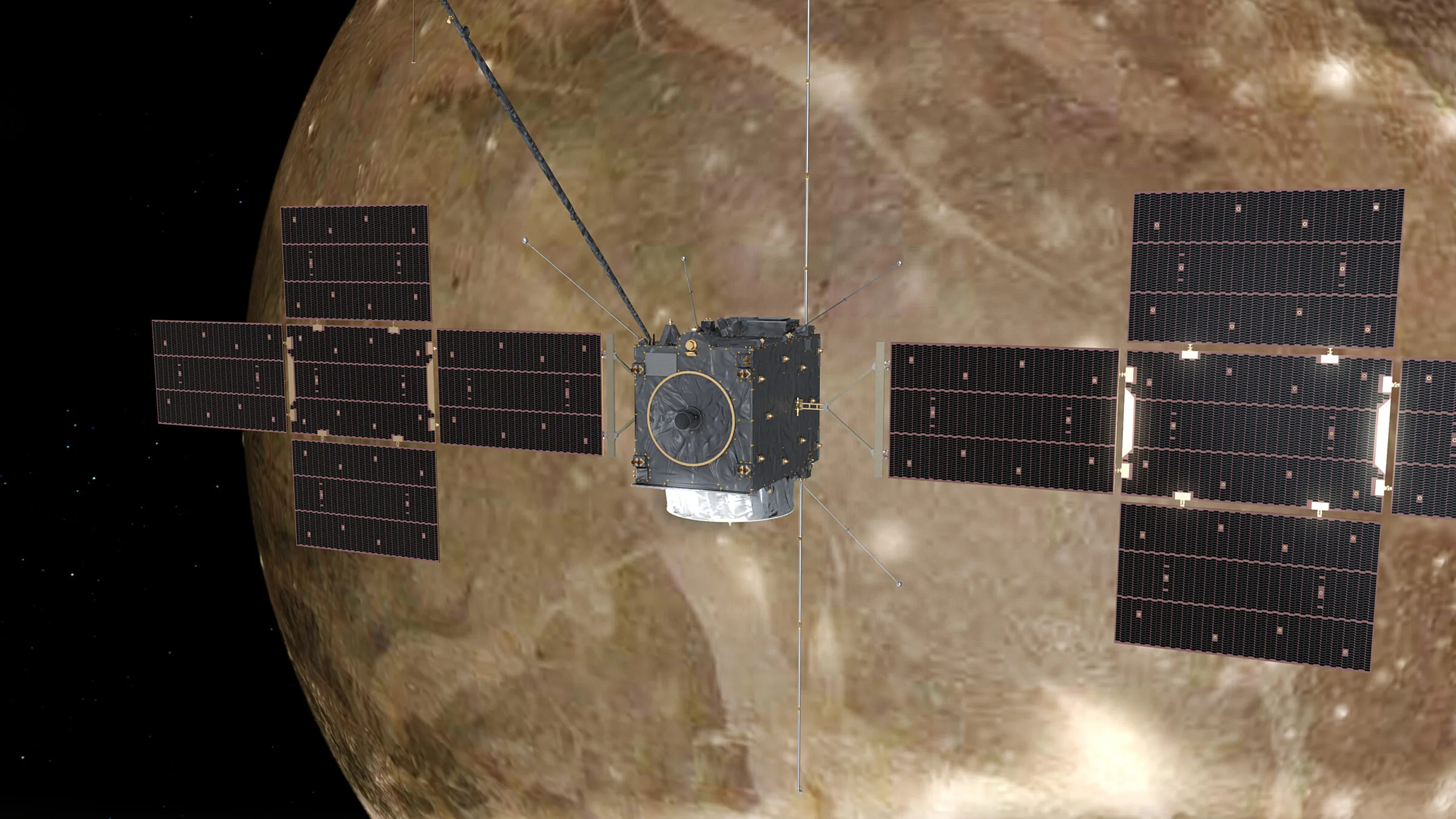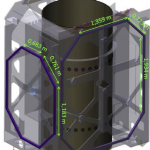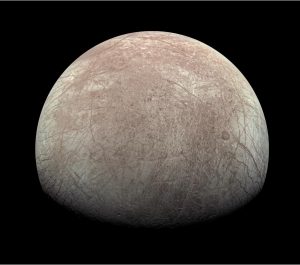
The JUICE Mission: Japan joins ESA to head to the icy moons
This month, the JUpiter ICy moon Explorer (JUICE) is set to embark on an eight year journey to the icy moons of our Solar System’s largest planet. While the moons have been previously observed by Jupiter explorers such as NASA’s Galileo, this is the first time a dedicated mission will visit the moons with an instrument suite targeted at their exploration. JUICE is an ESA-led mission, with strong involvement from Japan in both the instrument development and science teams.

The strangest habitable environments in the Solar System?
Jupiter has three icy moons whose surfaces are covered with solid ice but seem to harbour a global liquid water ocean below. Starting closest to Jupiter and moving out, these moons are Europa, Ganymede, and Callisto. The presence of water makes the icy moons one of the most promising sites in our Solar System for supporting a habitable environment. However, any signs of life would be tucked under the icy shell and impossible to observe remotely from Earth. The only way to know more about these intriguing habitats is therefore to visit.
The moons’ environment is wildly different from anything we have seen on the Earth or our neighbouring terrestrial planets. Apart from global sub-surface oceans, the moons are embedded in Jupiter’s colossal magnetic field which creates one of the most intense radiation environments in the Solar System. Electrically charged particles are trapped and accelerated to high speeds by the Jovian magnetic field, and pound down on the surfaces of the icy moons.
In the midst of this magnetic maelstorm, Ganymede promises a particularly strange location. While the rapid rotation of Jupiter’s magnetic forces causes a weak induced magnetic field around Europa and Callisto, Ganymede is one of only three rocky or icy worlds—and the only moon—in the Solar System to generate its own magnetic field. Ganymede therefore carves out a mini-magnetosphere within Jupiter’s engulfing forces, in which the two magnetic fields interact to produce an even more complex environment.
This makes Ganymede the principal scientific target of the JUICE mission, and the spacecraft will enter orbit around Ganymede after multiple fly-bys of all three icy moons.

Made in Japan
JUICE carries a suite of 10 instruments, four of which have components developed in Japan (GALA, PEP/JNA, RPWI and SWI), and Japanese researchers participate on the science program of a further two instruments (JANUS and J-MAG). It is a kit designed to probe both the interior of the moons and their surrounding intense environment.
GALA: measuring the landscape of Ganymede
“Ganymede’s surface topography is mainly composed of water ice, and is quite different from that of the terrestrial surface. Investigating the topography of such an icy world leads to further understanding of how it was formed, and how it has evolved, which are key issues in planetary science,” says Enya Keigo, PI of GALA-Japan.
The Ganymede Laser Altimeter (GALA) onboard JUICE is a precise and accurate distance measurer. While JUICE orbits Ganymede, GALA will emit laser pulses and detect their reflection from the moon’s surface. The time difference between the emitted and received pulses gives a distance measurement so precise that a map of Ganymede’s surface topology and shape to within a few metres can be achieved. The intensity of the reflected light also tells GALA about the reflectivity (albedo), slopes and roughness of the icy surface.
The Japanese team was responsible for part of the optical system inside GALA that converts the received laser light into a digital output. Enya Keigo describes the details of this challenge:
PEP/JNA: forecast of plasma rain
Embedded in Jupiter’s magnetic field, charged particles rain down on the surface of the icy moons. This plasma rain causes particles to be either backscattered or ejected from the ice, carrying with them information about the surrounding plasma in Jupiter’s clutches. These particles can be detected by PEP/JNA.
“Since the atmospheres of the icy moons are tenuous, plasma particles (ions and electrons) in the vicinity of Jupiter can reach the moon surface without loosing their energy through collision with atmospheric particles,” explains Asamura Kazushi, PI of PEP/JNA-Japan. “As a result, the projectile energy of the infalling particles remains high as it collides with the surface, and this induces the generation of back-scattered and sputtered particles.”
PEP/JNA is the Jovian Neutral Analyser (JNA) which is one of six sensors that form the Particle Environment Package (PEP) onboard JUICE. The Japan team developed the electronics boards for PEP/JNA. Asamura Kazushi discusses the PEP/JNA instrument:
RPWI: radio reflections from the deep
The Radio and Plasma Wave Investigation (RPWI) instrument suite onboard JUICE will probe the structure and motion of Jupiter’s strong magnetosphere, explore deeper inside the moons’ icy crust and oceans, and potentially even detect ionised plumes ejected through cracks in the moons’ surfaces.
The huge sensors on RPWI can measure the properties of the cold plasma (ions and electrons), detect the direction and magnitude of the electric and magnetic fields, as well as monitor radio emissions from the accelerated particles in Jupiter’s magnetic field. Detecting the radio emission reflecting from different depths of the icy moons acts as a passive radar (similar to GALA, but with Jupiter rather than RPWI emitting radio pulses) to probe the structure below the ice. Moreover, if the Jovian radio emission passes through a plume ejected from the moons’ surface, the change in the emission as it is partially blocked by the plume can reveal characteristics of the plume material.
The Japan team designed the high-frequency system (pre-amplifiers connected to the RWI three-axis antennas and high frequency receiver) for the radio observation capabilities in collaboration with the teams from Sweden, France, Poland and Australia, and also designed the software to monitor the energy exchange between the electromagnetic waves and ions in the plasma.
“We were able to confirm that our system has sufficient sensitivity to approach even the levels of the galactic radio background, which assures us that we will be able to see all strong and weak radio signals in the Jupiter system!” says Kasaba Yasumasa (Tohoku University). Kasaba discusses the details of RPWI:
SWI: the ingredients within a moon
SWI is the JUICE Submillimetre Wave Instrument will measure the intensity of the thermal emission from Jupiter’s atmosphere, and from the tenuous atmosphere and surface of the icy moons.
SWI is a spectrometer that measures the intensity of different wavelengths centred around 520 microns and 250 microns. At these wavelengths, volatiles such as methane, water, oxygen and carbon monoxide emit thermal radiation that SWI can detect. SWI receives the thermal radiation uses a reflector antenna for which the Japan group contributed the main reflector and sub-reflector, as well as motors.
One particular interest is the composition of volatiles on Callisto. The moon is thought to be the least active of Jupiter’s icy trio and may therefore the static moon’s atmosphere may preserve information of the composition of material that formed the icy system. Meanwhile, a detection of plumes from Europa and Ganymede would offer evidence of the geochemical process that lies beneath their surfaces, hinting at the possible ingredients for habitability.
J-MAG: moon magnets
J-MAG is the magnetometer onboard JUICE that measures magnetic fields. J-MAG will explore the configuration of the internal magnetic field of Ganymede, the induced fields surrounding Europa and Callisto, and also the magnetic fields wrapped around Jupiter itself.
Japanese members on the J-MAG team are assisting with the calibration of the J-MAG sensor alignment. J-MAG’s two sensors are situated close to the end of the magnetometer boom on JUICE. The mechanical stability of the long boom is not sufficient to constrain the absolute orientation of the sensors. The spacecraft therefore has two orthogonal coils wrapped around its main body (JACS) that generate a magnetic field when a current is run through the coils. The direction of this generated field is detected by the sensors and reveals their exact alignment.
This technology is similar to that used for the JAXA lunar orbiter, Kaguya, allowing the Japanese J-MAG team to apply the same analysis techniques developed for Kaguya to JUICE. Matsuoka Ayako (Kyoto University) discussing what the magnetometer will achieve:
JANUS: a history etched in ice
With the full latin moniker of “Jovis, Amorum ac Natorum Undique Scrutator”, JANUS is a camera to image the icy moons and Jupiter. The camera has 13 different filters over the wavelength range of 340 – 1080nm, covering the visible spectrum and into the near-infrared.
JANUS will record the landscapes of the icy moons, identifying surface features that can build a history of each of the icy moons. These could include signs of geology such as volcanism, tidal effects from the gravitational tug of the moons on one another, or properties of the ice indication variations in composition and density.
JANUS has been developed in Europe, with contributions from the Japan team particularly in the areas of specification and mission goals. This work will continue with preparations for observations with JANUS, as well as the analysis, data archiving, education and outreach. Haruyama Junichi discusses the instrument:
Journey to the icy moons
JUICE is scheduled to launch on April 13 from Europe’s Spaceport in Kourou, French Guiana. Between 2024 and 2029, JUICE will pass close to the Earth and Venus to receive gravitational assists from the planets to help the spacecraft on the trajectory into the outer Solar System and Jupiter.
JUICE will arrive at the Jupiter system in 2031 and make multiple fly-bys of Ganymede, Europa, and Callisto. In 2034, JUICE is due to enter orbit around Ganymede, becoming humankind’s the first icy moon orbiter.
Further information:






 Previous Post
Previous Post Next Post
Next Post






